In what United States Environmental Protection Agency (EPA) Administrator Lee Zeldin called the “most consequential day of deregulation in American history,” on Wednesday the EPA chief announced 31 deregulation actions that will roll back Biden-era environmental rules, including those concerning climate change, electric vehicles (EVs) and pollution limits for coal-fired power plants, reported The Associated Press.
If approved, Zeldin said the actions will lower prices for common expenses like home heat, purchasing a car and operating a business by eliminating trillions in “regulatory costs and hidden ‘taxes’.”
“Today is the greatest day of deregulation our nation has seen. We are driving a dagger straight into the heart of the climate change religion to drive down cost of living for American families, unleash American energy, bring auto jobs back to the U.S. and more,” Zeldin said in a press release from the EPA. “Alongside President Trump, we are living up to our promises to unleash American energy, lower costs for Americans, revitalize the American auto industry, and work hand-in-hand with our state partners to advance our shared mission.”
Of the dozens of environmental regulations set to be rolled back is an EPA finding from 2009 that greenhouse gases are a danger to public health and welfare. The Clean Air Act determination is the basis for a large number of climate regulations for power plants, automobiles and other sources of pollution.
Climate scientists and environmentalists consider the Obama-era endangerment finding a cornerstone of U.S. law, saying any attempt to reverse it is not likely to succeed.
“In the face of overwhelming science, it’s impossible to think that the EPA could develop a contradictory finding that would stand up in court,” said David Doniger, senior attorney and strategist with the Natural Resources Defense Council (NRDC), in an NRDC Expert Blog post. “Indeed, the courts have repeatedly rejected attacks on the finding. Even Trump’s first-term EPA administrators understood that reversing it was ‘a fool’s errand,’ in the words of one conservative former agency official.”
Among the other regulations set to be “reconsidered” by the EPA are “regulations throttling the oil and gas industry”; mercury standards that the agency said “improperly targeted coal-fired power plants”; the Greenhouse Gas Reporting Program; and regulations for wastewater from coal plants.
“From the campaign trail to Day 1 and beyond, President Trump has delivered on his promise to unleash energy dominance and lower the cost of living,” Zeldin said in a video. “We at E.P.A. will do our part to power the great American comeback.”
Zeldin spoke of the changes without mentioning the EPA’s guiding principles: to protect the environment and public health.
In an explanation of the EPA’s mission, the first Administrator of the EPA William D. Ruckelshaus said the agency has “no obligation to promote agriculture or commerce; only the critical obligation to protect and enhance the environment.”
Weeks following the creation of the EPA by former President Richard M. Nixon in 1970, Ruckelshaus said its focus would be on research, as well as five areas of standards and enforcements: air and water pollution, pesticides, waste disposal and radiation, The New York Times reported.
Zeldin said limits on smokestacks linked to respiratory issues and premature deaths would be overturned, along with the Clean Air Act’s “Good Neighbor” provision requiring states to be responsible for their own pollution when it is blown into neighboring states. The EPA would also do away with enforcement efforts prioritizing the safety of predominantly poor and minority communities.
When environmental policy is created by the agency, Zeldin said it will no longer take into consideration the societal costs of storms, wildfires, droughts and other disasters that could be worsened by pollution connected to the policy.
The EPA’s announcements are not legally binding, and in nearly every case the agency would need to undergo a lengthy public comment process, as well as formulate economic and environmental justifications for each revision.
Environmentalists and democrats accused Zeldin of deserting the responsibility of the EPA to safeguard the environment and human health.
“Today is the day Trump’s Big Oil megadonors paid for,” said Democratic Senator from Rhode Island Sheldon Whitehouse, as reported by The New York Times. “Administrator Zeldin clearly lied when he told us that he would respect the science and listen to the experts.”
Jackie Wong, NRDC’s senior vice president for climate change and energy, said weakening the rules would result in increases in health problems like heart attacks and asthma.
“At a time when millions of Americans are trying to rebuild after horrific wildfires and climate-fueled hurricanes, it’s nonsensical to try to deny that climate change harms our health and welfare,” Wong said.
Gina McCarthy, EPA administrator during the Obama administration, called it “the most disastrous day in EPA history. Rolling these rules back is not just a disgrace, it’s a threat to all of us. The agency has fully abdicated its mission to protect Americans’ health and well being.”
The post ‘The Day Trump’s Big Oil Megadonors Paid for’: EPA Chief Zeldin Announces Rollback of 31 Landmark Environmental Regulations appeared first on EcoWatch.
https://www.ecowatch.com/epa-zeldin-environmental-regulations-rollback.html
Green Living
6 Best Non Toxic Diapers For Babies
Last Updated on October 15, 2025
Did you know the average newborn goes through 10-12 diapers per day? That’s a lot of waste – and a lot of time spent in diapers.
Most babies have more sensitive skin than adults, as their skin hasn’t fully developed yet. The protective hydrolipidic film is still very thin, which makes infant skin more vulnerable to harsh external factors.

Some of the links in this post are affiliate links; for more information please see my disclosure policy.
Those external factors include diapers. Babies spend a lot of time getting in (and out) of them. So it’s important to choose non toxic diapers that are gentle on both skin and planet. Here are the best non toxic diapers on the market.
which diapers are the least toxic?
The diapers that are least toxic include ones made from plant-based or cotton materials. Look for brands that omit harsh chemicals like chlorine, phthalates, and PFAs.
Many diaper components are made up of plastic, which is hard to avoid in the name of efficiency.
That being said, it’s best to choose diapers from brands that minimize the amount of plastic in their products. Plastic materials can emit VOCs known to harm health.
Here are some general guidelines to adhere to when choosing diapers:
- Choose diapers that disclose the ingredients (some don’t!). Avoid anything with fragrance, lotion, or other skin-conditioning adhesives.
- Look for brands that minimize the amount of plastic in their products.
- Consider cloth diapers, ideally made from organic cotton.
- Opt for brands that use unbleached pulp or pulp bleached without chlorine
- Try to choose plain, undyed diapers with minimal designs (dyes can be contaminated with toxic heavy metals).
- Check for certifications like Forest Stewardship Council or EWG certified.
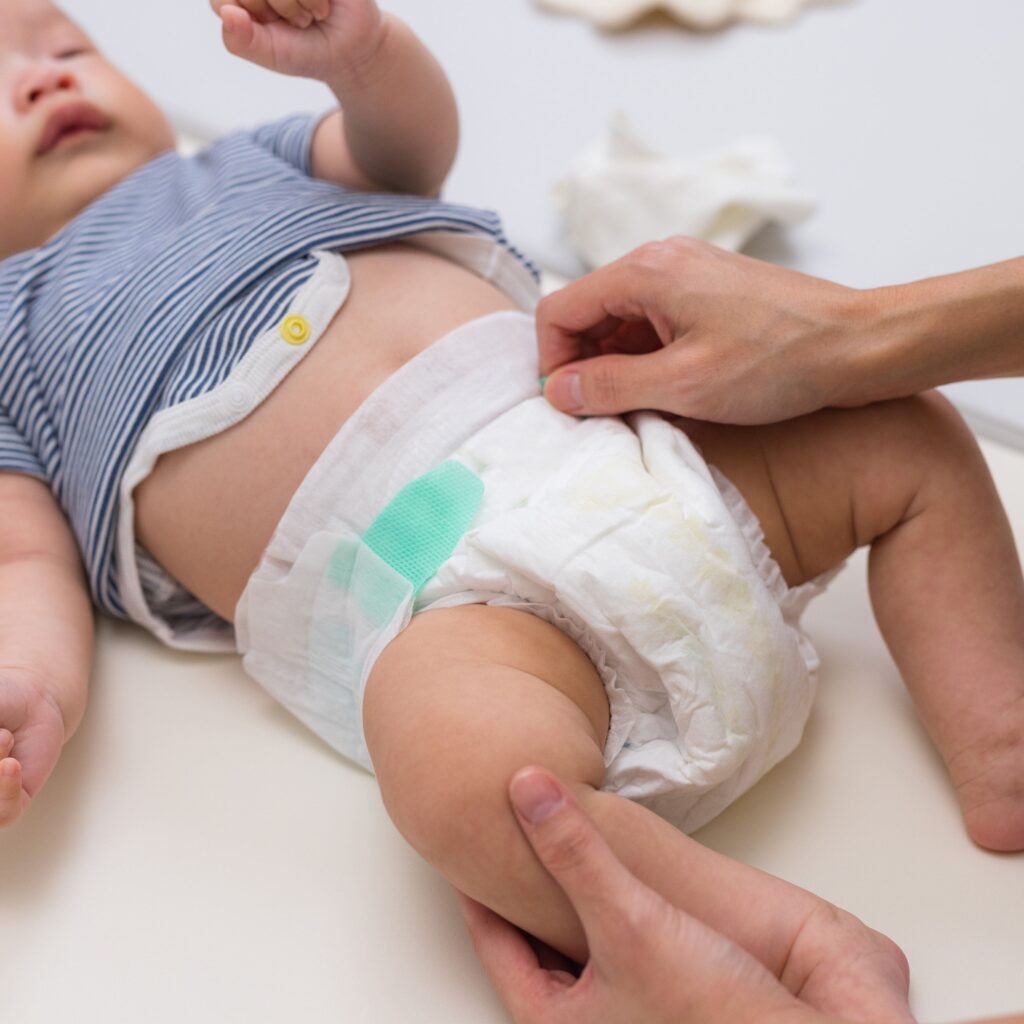
is Huggies or Pampers less toxic?
In terms of being less toxic, Huggies has stated all of their diapers are free of fragrances, phthalates, parabens, and elemental chlorine. They’ve also partnered with Terracycle to offer plastic film recycling options.
Pampers diapers are made without parabens, natural rubber latex and elemental chlorine. But only their Pure diapers are made without fragrance (and many mothers online have complained of Pampers’ strong scent).
However, Pampers’ factories are zero manufacturing waste to landfill and they use FSC certified wood pulp.
Both brands list their ingredients on their websites, so definitely read them for yourself before making a purchase. Just be mindful both brands also use colorants and printing inks to make designs and/or color change technology.
which diaper brands are safe for babies?
The diaper brands safe for babies are listed below. There’s a mix of disposable and cloth diapers, so there’s something for everyone.
However, be mindful that every baby is different and what works for one, doesn’t always work for another. For example, certain brands may fit your baby like a glove, whereas others may be too big: It’s all about experimenting and finding what works for your baby.
You can use this list as a starting point to help you choose a better, safer choice for your child. None of the brands listed here use fragrance, parabens, or other harsh chemicals.
I’ve gone ahead and highlighted some of my favorite features of each brand, but it isn’t an exhaustive list. Be sure to check out their websites for more information.
Also, if you cloth diaper, don’t forget to consider eco-friendly baby detergent brands because you’ll be doing a bit more laundry!
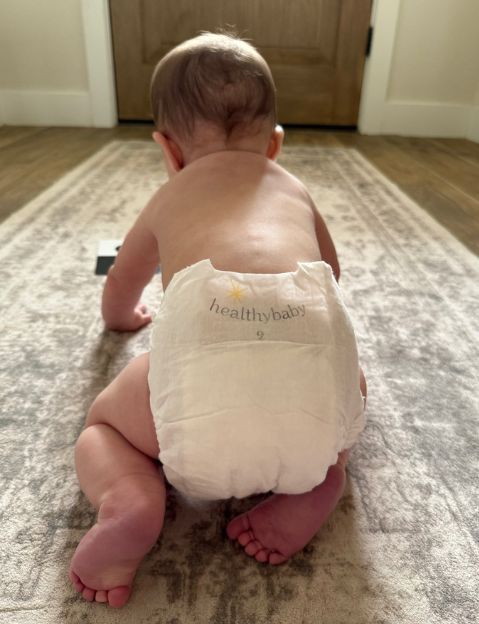
1. healthy baby
- Offers disposable and cloth diapering options
- Six sizes, not including newborn (N or N/1)
- Plant-based materials including organic cotton + FSC certified pulp
- 12 hour leak protection
- No chemical wetness indicator
- EWG certified
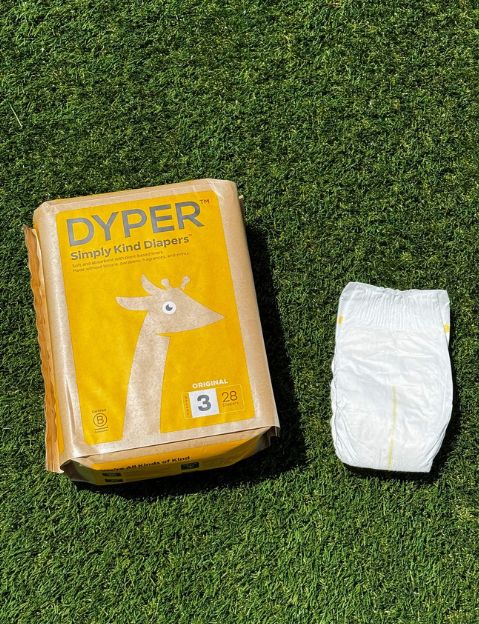
2. dyper
- Disposable diapers
- Six sizes, not including newborn (NB)
- Plant-based materials, including FSC-certified pulp
- 12-hour leak protection
- No inks, prints or dyes
- Offers REDYPER service to compost diapers through weekly pickup
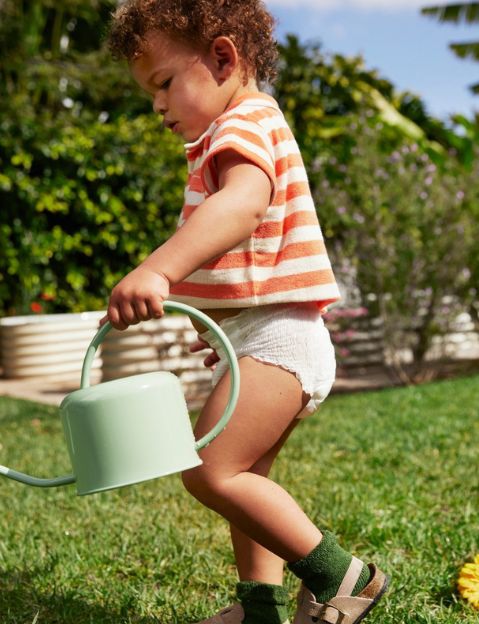
3. coterie
- Disposable diapers
- Seven sizes, not including newborn (N or N+1)
- 25% plant-based, made with wood pulp from sustainably manages forests
- 12-hour leak protection
- Wetness indicator
- Cruelty-free
- OEKO-TEX STANDARD 100 Certified
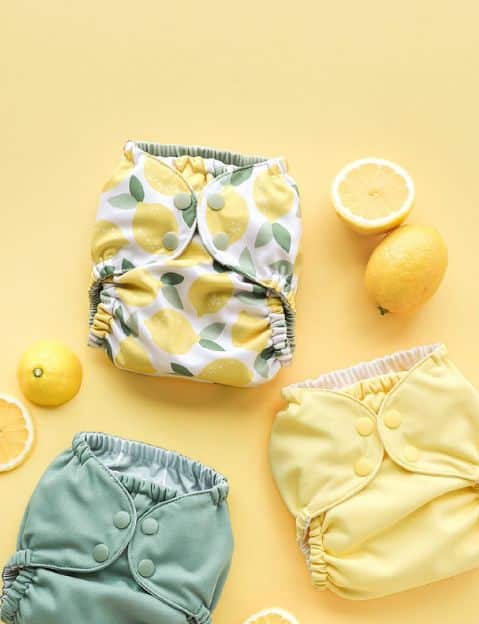
4. esembly baby
- Cloth diapers
- Two sizes, based on pounds
- Made of organic cotton + upcycled TPU
- Recommended to change an awake baby every 2-3 hours
- Wet bags sold separately to hold dirty diapers while out
- Pre-loved options to buy and sell available
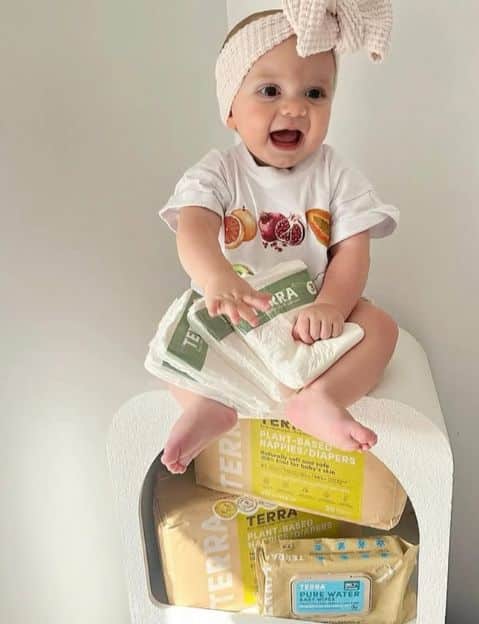
5. terra
- Disposable diapers
- Six sizes
- 85% plant-based, including FSC-certified pulp
- 12-hour leak-proof protection
- Plant-based wetness indicator
- Ink on product + packaging is food grade
- Packaging is made from recyclable kraft paper + rice
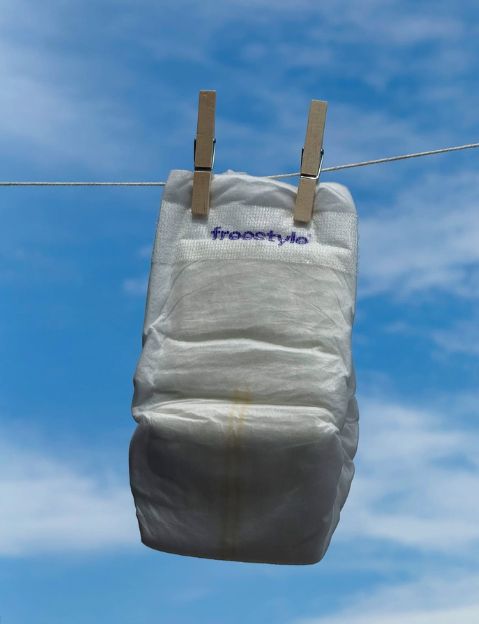
6. freestyle
- Disposable diapers
- Six sizes
- 7-layer protection for 14x better absorption
- Delivered in 1 month long supplies
- FSC certified pulp
- EWG verified
Which of these sustainable diaper options would you choose? Let me know in the comments!
The post 6 Best Non Toxic Diapers For Babies appeared first on Going Zero Waste.
Green Living
The Many Layers of Personal Style
Personal style is a dance between dualities: fashion as art and fashion as function; clothing as self-expression and clothing for our circumstances.
Style is a medium for communication and self-expression, yes. But it’s also shaped by the environments and requirements around us, from workplace dress codes to city cultures, climates, and specific occassions.
In last Saturday’s workshop, where we talked about how to remix what you already have in your closet, attendees shared a common challenge:
How do you balance your personal style expression while dressing for the various situations and environments we operate in?
“I’ve found above all else my style is highly influenced by my environment (my job, my city etc.)—sometimes it becomes about ‘fitting in’ and losing individuality”
“I find I’m too led by my day-to-day lifestyle. I WFH and so often I just don’t get dressed at all.”
“There are too many applications: workout, work, at home, formal occasion.”
Style as Identity vs. Style as Communication
It’s no wonder style and getting dressed can feel so confusing.
In the personal style world, we learn to dress for who we are on the inside. And then we see the style rules in fashion media: here’s how to dress for this season, this dress code, this city.
And in our real lives, we have real dress codes we might have to follow, whether for a workplace or a wedding.
But what if all those sides conflict?
- If my style words are “casual” or “sporty” but I’m in a workplace 40+ hours a week that requires business formal, where does that leave my personal style?
- If I love vibrant and artsy looks, but I live in a city full of neutrals, what do I wear?
It’s no surprise it feels… complicated.
Here’s my take.
We’re Not One-Dimensional — Neither is Our Style
Sometimes I want to disconnect and live in cottage in the mountains, surrounded by more trees than people. Other days I dream of having an apartment in the center of Paris where I see more people in a day than live in my hometown.
I’m light, joyful, maybe even quirky with friends. I’m ambitious, intentional, perhaps more serious in work. There are times I feel it’s best to soften and let it go; other times it feels most aligned to be unapologetically outspoken.
We are human. We’re social creatures. We’re complex and full of contradictions.
Social media has trained us to fit people into neat boxes because “niche” is what performs in the algorithm.
In real life, though, our “authentic” selves aren’t so one-dimensional.
I’m not speaking to new networking contacts the same exact way I talk to my best friend I’ve known for years. That doesn’t mean I’m pretending to be someone else. It just means I’m showing up a bit differently depending on the context.
Similarly, our personal style doesn’t have to be expressed in one singular way.
That’s what’s beautiful about fashion! We have the opportunity to express ourselves a bit differently each and every time we get dressed.
What we wear might ebb and flow with a situation, the season, or our mood. There are common threads, but differentiators too.
Three distinctly different looks can all be authentic.
For me, personal style isn’t about being setting such rigid parameters that we can no longer embrace our multi-dimensional nature.
And there’s undoubtedly the layers of privilege at work here too. Is it safe to dress in alignment with your true identity in that particular situation? Will you be taken seriously? Could there be repercussions?
There’s a lot to untangle when it comes to what we wear.
Making Our Multi-Dimensional Style Practical
As I shared in last week’s workshops, style is many layers. The four I see it through are the vibe, the shapes, the colors & textures, and our lifestyle & values.

The aesthetic reflects your vibe, mood or style adjectives.
- For example, my vibe or adjectives are feminine, structured, grounded.
The shapes are the fits, silhouettes, and proportions you love.
- I often wear outfits with a straight silhouette or tailored fit balanced with a relaxed, flowy, or drapey element.
Colors & textures include your preferred palettes, fabrics, and the way materials feel.
- I prefer wearing natural fibers when possible. I like gold jewelry, and I feel more aligned in lower contrast looks. Lighter colors for day. Sometimes darker for evening or certain events.
The lifestyle & values element is the consideration of your actual day-to-day. What situations and environments are you dressing for? What is important to you?
- I work from home so comfort is key most of the time. I value slow fashion practices — rewearing, repairing, and supporting circular practices and sustainably-minded brands.
Once you understand these layers of your style, the next step is figuring out how to apply them in real-life situations.
Applying Your Style to the Situation
In last week’s workshops, I talked about the role of outfit templates here for various situations. What is the foundational blueprint of what you might wear to your office, working from home, in a school setting, at home, running errands, and so on?
There are opportunities to bring in the layers of your personal style in these various situations, but it does require some intentionally on the outset. Otherwise, it’s easy to fall into our old patterns or copy what others around us wear. (Even subconsciously, as fashion psychologist Shakaila Forbes-Bell has shared!)

Here’s one of my work-from-home outfit templates that balances style and situational needs:
- Blouse with feminine detail: I start with the top for Zoom calls!
- Straight-leg bottoms: this could be jeans, colorful pants, or a column skirt
- Slim shoes: the general “slim” descriptor makes it versatile across seasons
- Structured bag: an option to add polish when coworking at a café
By thinking in these various layers (vibe, shapes, colors & textures, and lifestyle & values) you can build outfits that feel authentic to you while fitting the constraints of the external situation.
What About One-Off Unique Situations?
Like this Wednesday evening, I spoke on a “Sustainable Fashion in Action” panel with Chicago Climate Connect during Sustainable Fashion Week Chicago. But the panel was also taking place at the Patagonia x Worn Wear store.
So the vibe was professional meets fashion, but also kinda casual?! And we are still in the Midwest here. I have to say, this one wasn’t easy.
But here’s the step-by-step thought process that helped me balance my style, function, and a unique-to-me context.

- I picked a foundational piece: My navy wide-leg trousers were business casual without being too formal and were practical for train travel.
- And functional accessories:My old Coach bag fits everything and my chunky Veja sneakers matched the vibe I was going for so those were the picks.
- Then a piece that brought it all together:At this point I was mixing high-contrast colors (white with navy & black) and different vibes (trousers vs. sneakers). I felt like I needed a bridge for the outfit, and this navy-striped vest tied it all together.
- Finally, some final touches: Gold jewelry made the look feel more “me”, while this cap from Abbie at The Filtery made it all feel effortless.
In the end, this outfit took a lot longer to create than a typical look.
It took longer to create than my usual outfits, but it felt just right. The combination was practical, suited my style, fit the vibe of the panel, and aligned with the weather.
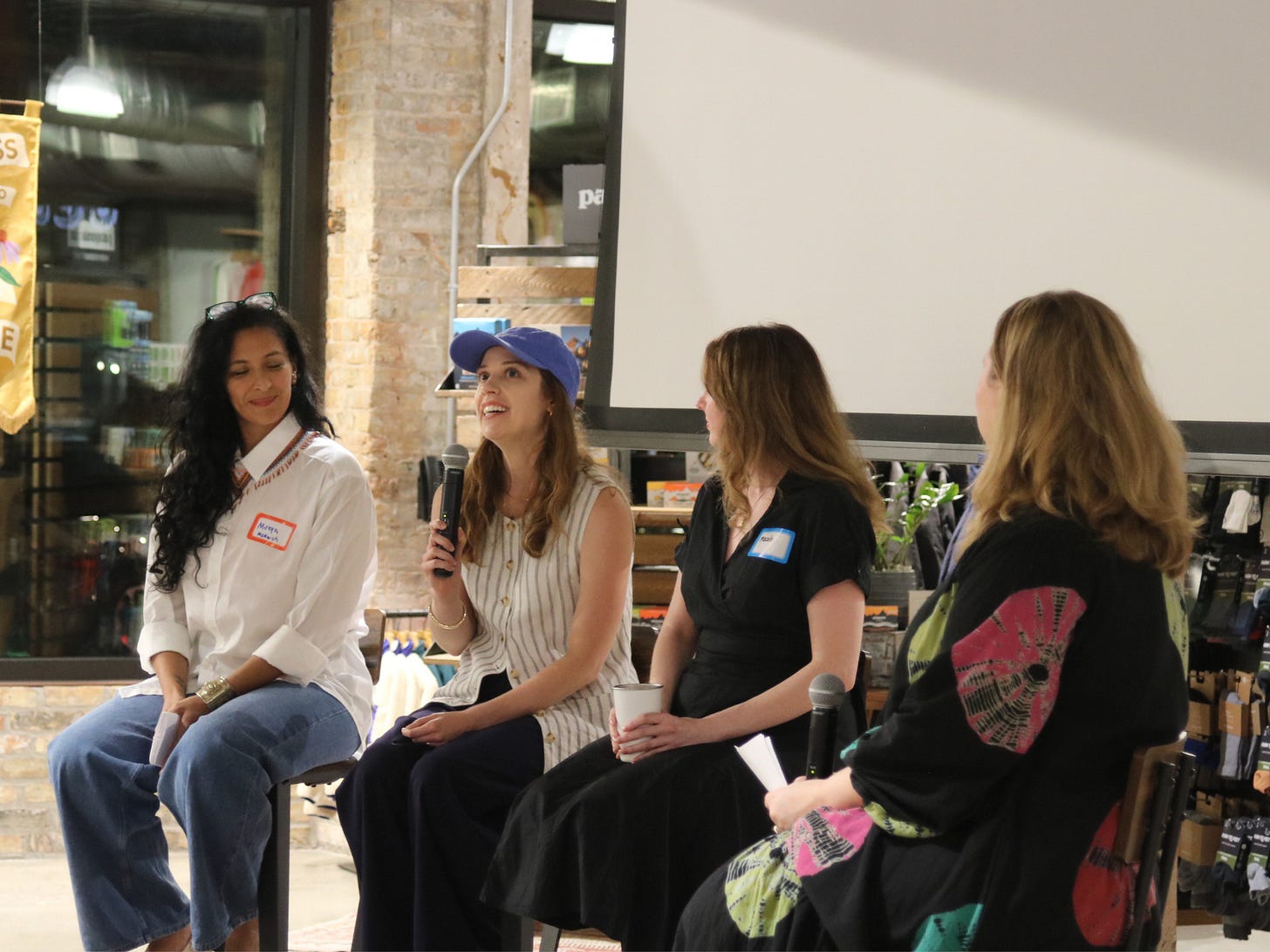
This panel outfit reminded me that style is what we wear to express ourselves, but it’s also a tool to help us navigate our lives. By thinking through these layers of personal style (vibe, shapes, colors, textures, and lifestyle needs) we can balance showing up authentically while honoring the nuances or navigating the constraints of a situation.
For me, that’s the real power of personal style.
One single outfit can’t tell the whole story of who we are. But personal style can be flexible, functional, and expressive of the many sides of our multi-dimensional nature.
So lately, more than asking “does this outfit perfectly express my full self?” I’ve been finding myself asking:
“Does this outfit help me show up in the way I want to? Does it say what I want it to say in this particular moment?“
The post The Many Layers of Personal Style appeared first on .
Green Living
You’re multi-dimensional. So is your style.
Personal style is a dance between dualities: fashion as art and fashion as function; clothing as self-expression and clothing for our circumstances.
Style is a medium for communication and self-expression, yes. But it’s also shaped by the environments and requirements around us, from workplace dress codes to city cultures, climates, and specific occassions.
In last Saturday’s workshop, where we talked about how to remix what you already have in your closet, attendees shared a common challenge:
How do you balance your personal style expression while dressing for the various situations and environments we operate in?
“I’ve found above all else my style is highly influenced by my environment (my job, my city etc.)—sometimes it becomes about ‘fitting in’ and losing individuality”
“I find I’m too led by my day-to-day lifestyle. I WFH and so often I just don’t get dressed at all.”
“There are too many applications: workout, work, at home, formal occasion.”
Style as Identity vs. Style as Communication
It’s no wonder style and getting dressed can feel so confusing.
In the personal style world, we learn to dress for who we are on the inside. And then we see the style rules in fashion media: here’s how to dress for this season, this dress code, this city.
And in our real lives, we have real dress codes we might have to follow, whether for a workplace or a wedding.
But what if all those sides conflict?
- If my style words are “casual” or “sporty” but I’m in a workplace 40+ hours a week that requires business formal, where does that leave my personal style?
- If I love vibrant and artsy looks, but I live in a city full of neutrals, what do I wear?
It’s no surprise it feels… complicated.
Here’s my take.
We’re Not One-Dimensional — Neither is Our Style
Sometimes I want to disconnect and live in cottage in the mountains, surrounded by more trees than people. Other days I dream of having an apartment in the center of Paris where I see more people in a day than live in my hometown.
I’m light, joyful, maybe even quirky with friends. I’m ambitious, intentional, perhaps more serious in work. There are times I feel it’s best to soften and let it go; other times it feels most aligned to be unapologetically outspoken.
We are human. We’re social creatures. We’re complex and full of contradictions.
Social media has trained us to fit people into neat boxes because “niche” is what performs in the algorithm.
In real life, though, our “authentic” selves aren’t so one-dimensional.
I’m not speaking to new networking contacts the same exact way I talk to my best friend I’ve known for years. That doesn’t mean I’m pretending to be someone else. It just means I’m showing up a bit differently depending on the context.
Similarly, our personal style doesn’t have to be expressed in one singular way.
That’s what’s beautiful about fashion! We have the opportunity to express ourselves a bit differently each and every time we get dressed.
What we wear might ebb and flow with a situation, the season, or our mood. There are common threads, but differentiators too.
Three distinctly different looks can all be authentic.
For me, personal style isn’t about being setting such rigid parameters that we can no longer embrace our multi-dimensional nature.
And there’s undoubtedly the layers of privilege at work here too. Is it safe to dress in alignment with your true identity in that particular situation? Will you be taken seriously? Could there be repercussions?
There’s a lot to untangle when it comes to what we wear.
Making Our Multi-Dimensional Style Practical
As I shared in last week’s workshops, style is many layers. The four I see it through are the vibe, the shapes, the colors & textures, and our lifestyle & values.

The aesthetic reflects your vibe, mood or style adjectives.
- For example, my vibe or adjectives are feminine, structured, grounded.
The shapes are the fits, silhouettes, and proportions you love.
- I often wear outfits with a straight silhouette or tailored fit balanced with a relaxed, flowy, or drapey element.
Colors & textures include your preferred palettes, fabrics, and the way materials feel.
- I prefer wearing natural fibers when possible. I like gold jewelry, and I feel more aligned in lower contrast looks. Lighter colors for day. Sometimes darker for evening or certain events.
The lifestyle & values element is the consideration of your actual day-to-day. What situations and environments are you dressing for? What is important to you?
- I work from home so comfort is key most of the time. I value slow fashion practices — rewearing, repairing, and supporting circular practices and sustainably-minded brands.
Once you understand these layers of your style, the next step is figuring out how to apply them in real-life situations.
Applying Your Style to the Situation
In last week’s workshops, I talked about the role of outfit templates here for various situations. What is the foundational blueprint of what you might wear to your office, working from home, in a school setting, at home, running errands, and so on?
There are opportunities to bring in the layers of your personal style in these various situations, but it does require some intentionally on the outset. Otherwise, it’s easy to fall into our old patterns or copy what others around us wear. (Even subconsciously, as fashion psychologist Shakaila Forbes-Bell has shared!)
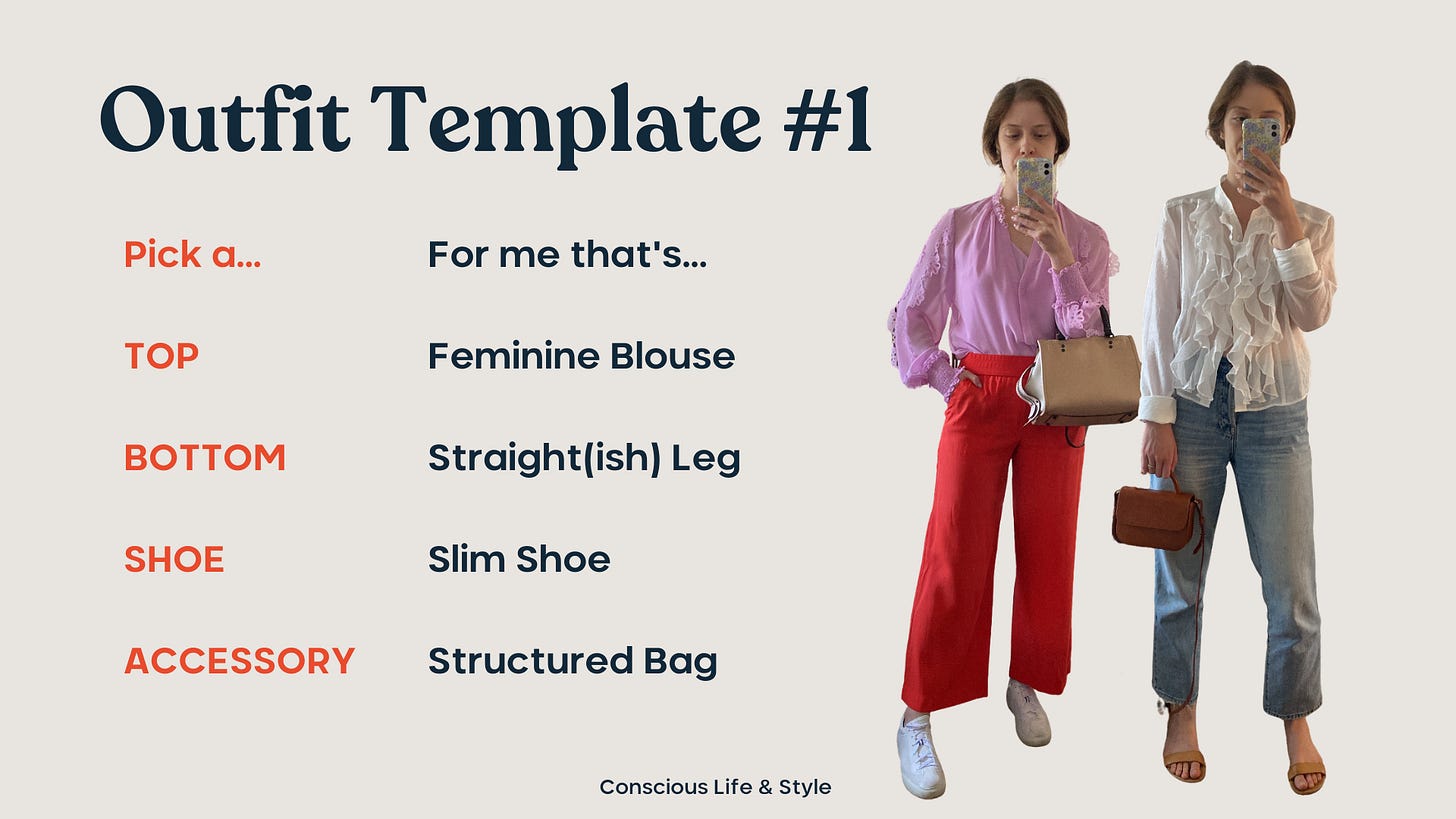
Here’s one of my work-from-home outfit templates that balances style and situational needs:
- Blouse with feminine detail: I start with the top for Zoom calls!
- Straight-leg bottoms: this could be jeans, colorful pants, or a column skirt
- Slim shoes: the general “slim” descriptor makes it versatile across seasons
- Structured bag: an option to add polish when coworking at a café
By thinking in these various layers (vibe, shapes, colors & textures, and lifestyle & values) you can build outfits that feel authentic to you while fitting the constraints of the external situation.
What About One-Off Unique Situations?
Like this Wednesday evening, I spoke on a “Sustainable Fashion in Action” panel with Chicago Climate Connect during Sustainable Fashion Week Chicago. But the panel was also taking place at the Patagonia x Worn Wear store.
So the vibe was professional meets fashion, but also kinda casual?! And we are still in the Midwest here. I have to say, this one wasn’t easy.
But here’s the step-by-step thought process that helped me balance my style, function, and a unique-to-me context.
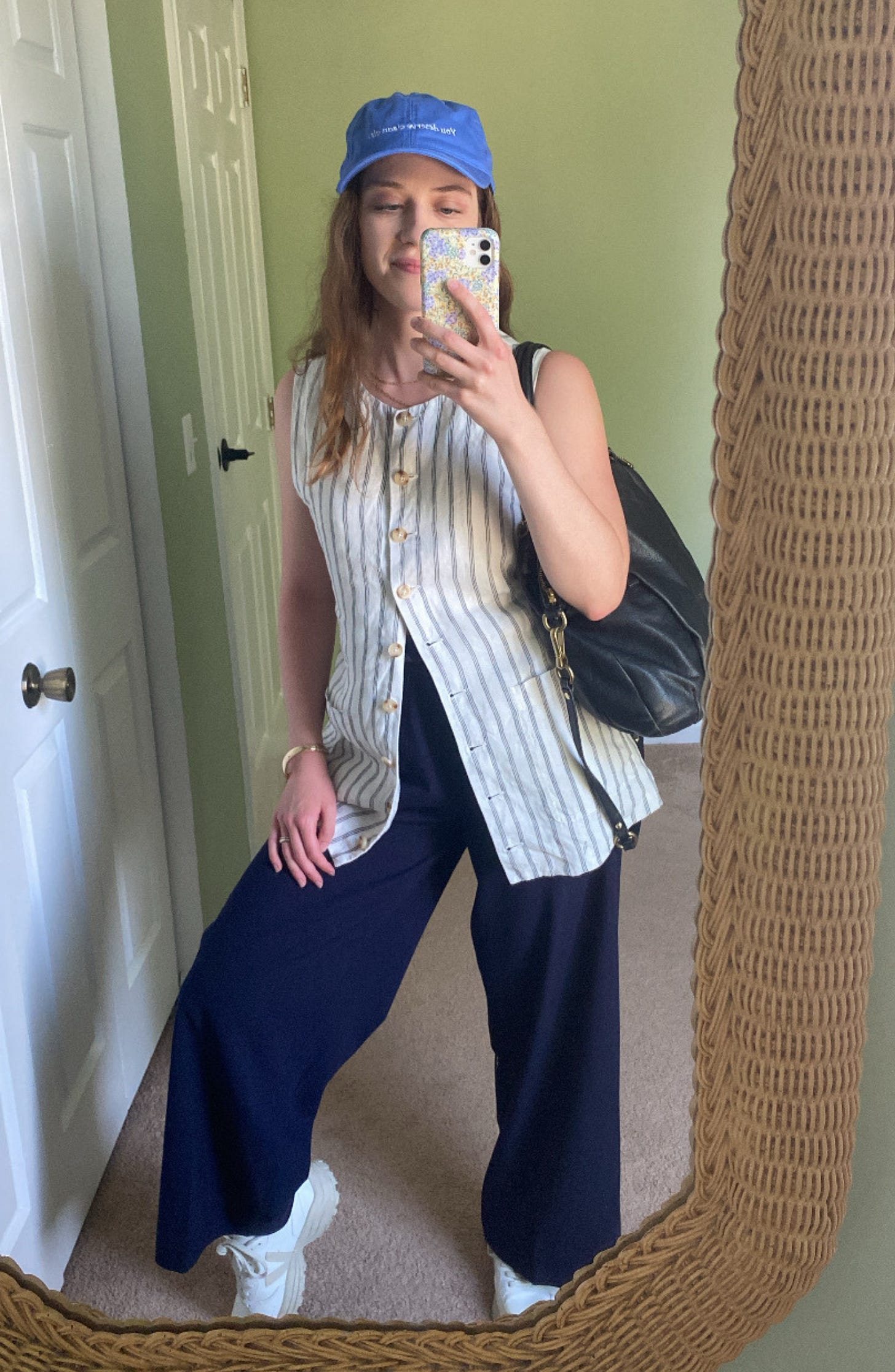
- I picked a foundational piece: My navy wide-leg trousers were business casual without being too formal and were practical for train travel.
- And functional accessories:My old Coach bag fits everything and my chunky Veja sneakers matched the vibe I was going for so those were the picks.
- Then a piece that brought it all together:At this point I was mixing high-contrast colors (white with navy & black) and different vibes (trousers vs. sneakers). I felt like I needed a bridge for the outfit, and this navy-striped vest tied it all together.
- Finally, some final touches: Gold jewelry made the look feel more “me”, while this cap from Abbie at The Filtery made it all feel effortless.
In the end, this outfit took a lot longer to create than a typical look.
It took longer to create than my usual outfits, but it felt just right. The combination was practical, suited my style, fit the vibe of the panel, and aligned with the weather.

This panel outfit reminded me that style is what we wear to express ourselves, but it’s also a tool to help us navigate our lives. By thinking through these layers of personal style (vibe, shapes, colors, textures, and lifestyle needs) we can balance showing up authentically while honoring the nuances or navigating the constraints of a situation.
For me, that’s the real power of personal style.
One single outfit can’t tell the whole story of who we are. But personal style can be flexible, functional, and expressive of the many sides of our multi-dimensional nature.
So lately, more than asking “does this outfit perfectly express my full self?” I’ve been finding myself asking:
“Does this outfit help me show up in the way I want to? Does it say what I want it to say in this particular moment?“
The post You’re multi-dimensional. So is your style. appeared first on .
-
Climate Change2 years ago
Spanish-language misinformation on renewable energy spreads online, report shows
-
Climate Change2 months ago
Guest post: Why China is still building new coal – and when it might stop
-
Climate Change Videos2 years ago
The toxic gas flares fuelling Nigeria’s climate change – BBC News
-

 Greenhouse Gases1 year ago
Greenhouse Gases1 year ago嘉宾来稿:满足中国增长的用电需求 光伏加储能“比新建煤电更实惠”
-
Greenhouse Gases2 months ago
Guest post: Why China is still building new coal – and when it might stop
-

 Climate Change1 year ago
Climate Change1 year ago嘉宾来稿:满足中国增长的用电需求 光伏加储能“比新建煤电更实惠”
-

 Carbon Footprint2 years ago
Carbon Footprint2 years agoUS SEC’s Climate Disclosure Rules Spur Renewed Interest in Carbon Credits
-
Renewable Energy3 months ago
US Grid Strain, Possible Allete Sale



